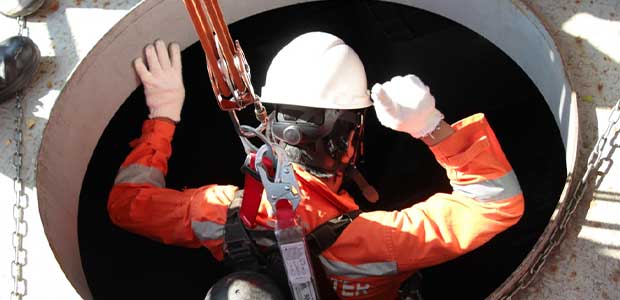
When Things Heat Up, Confined Spaces Can Become More Harrowing
While not every confined space is hazardous, by its nature, confined spaces carry the potential to become dangerous – sometimes in a matter of seconds.
- By Mark Heuchert
- Aug 05, 2021
Confined spaces can be harrowing environments. Some can be cramped and poorly ventilated, while others are exposed directly to the heat of the sun and, in either case, can be prone to extreme temperatures. So, when a worker’s job responsibilities necessitate Confined Space Entry (CSE), it can be an especially hazardous duty.
According to OSHA, a confined space includes three components: the space is large enough for an employee to enter and perform work, it has limited or restricted means for entry or exit and it is not designed for continuous occupancy. While not every confined space is hazardous, by its nature, confined spaces carry the potential to become dangerous – sometimes in a matter of seconds. In fact, more than a thousand workers have died in confined spaces in the past decade. While safety managers and industrial engineers are working hard to change processes and use technology to either remove hazards or the need for workers to perform maintenance or work, for now Confined Space Entry continues to be a necessary aspect of the majority of industrial operations.
Needless to say, a safe confined space operation requires a thorough understanding of the environment and its particular dangers, proper CSE training, ample advanced planning and appropriate PPE that can include with everything from gloves and protective eyewear to a Self-Contained Breathing Apparatus (SCBA) and portable gas detection devices.
Too Hot to Handle
Not all confined spaces are the same. Some environments present the potential for intense, dangerous heat. In more conventional confined spaces, boilers, steam pipes and other industrial equipment can all contribute to heightened temperatures. However, a Texas attic or rooftop in August can also expose workers to dangerous temperatures.
“Normal” body temperatures can range from 97°F (36.1°C) to 99°F (37.2°C). Prolonged exposure to extreme heat can cause heat exhaustion – and if someone’s body temperature reaches 104°F (40°C) or higher, it can lead to a “heatstroke,” which can be extremely dangerous, even fatal, if not identified and treated immediately.
Normally, our bodies have the ability to regulate themselves, so even when the air temperature within a working environment is higher than our average body temperatures, we can still cool down. However, if a worker is wearing heavy protective clothing or doing a particular task that requires them to be especially active, even lower air temperatures can prove dangerous. The same is true in high humidity – sweat is slow to evaporate when the air is already saturated.
These factors are important to remember and critical to plan for as facility managers consider their safety protocols. Several steps are critical to protect workers from the potential effects of extreme heat.
Steps to Protecting Workers
• Recognize the Risk Factors. According to OSHA, there are several factors that contribute to a higher risk for heat-related illnesses.
- High temperature and/or humidity, direct sun exposure, no breeze, wind or air circulation
- Heavy physical labor - Waterproof or “unbreathable” clothing
- A worker having minimal fluid intake
- A worker is newly exposed to a heated work environment
• Be Able to Spot the Signs of Heat Stress or Stroke. Heat stress and heat stroke have similar symptoms. In the case of a heat stroke, however, sufferers often experience symptoms more quickly and severely to reach the point of collapse. It’s important to know these symptoms, so one can recognize them and react immediately if he or a co-worker begins to show signs of distress.
- Headache, dizziness and confusion
o Loss of appetite and nausea
- Sweating, with pale clammy skin
- Cramps in the arms, legs and abdomen
- Rapid, weakening breathing (and pulse)
Evaluate the Environment. When planning a job, consider the temperature inside and outside the confined space, keeping in mind that the more physical the job, the more likely it is that the temperature inside the space will rise quickly. You must also consider the gear a worker will be expected to wear. Lastly, time work to avoid the extreme heat of the day.
• Take Proper Precautions. If extreme heat is probable or a worker’s overheating is possible, take the proper precautions. Establish protocols that allow workers to take frequent breaks. Remove any obstacles that would hinder workers from exiting the space quickly or keep responders from reaching someone in need of rescue. Most importantly, equip workers with knowledge and extensive training so they understand the nuances and dangers associated with confined spaces, including extreme heat.
• Provide Appropriate PPE. PPE is not one size fits all – determining the right gear depends on the nature of a confined space and the job to be performed. However, several PPE characteristics should be universal. It should be sized to fit and be worn properly; it should be kept on for the duration of the job; it should be well maintained and regularly inspected to ensure it is in good working condition when needed.
Confined spaces can be inherently risky and uncomfortable, and heat only adds to the level of risk and discomfort. In order to ensure worker safety, it is incumbent on everyone involved to understand the risks and the necessary protocols and precautions to protect those performing the work. Everyone who works with them, their co-workers, supervisors and facility managers can do their part by helping to mitigate the risks and by looking out for their colleagues.